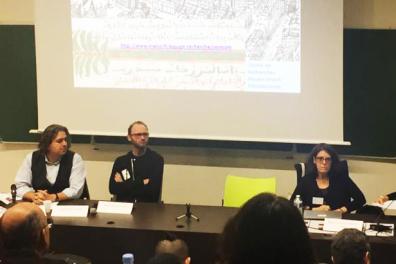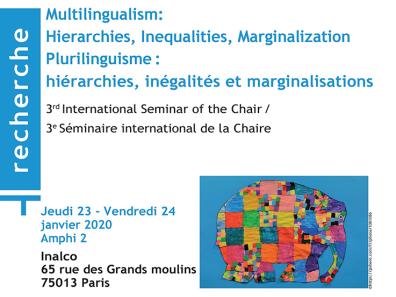Seminar on Language Planning for Multilingualism

3rd International Seminar of the UNESCO Chair on Language Planning for Multilingualism
INALCO, January 2020
Anuradha Kanniganti
ASUH
Institutional Adjoint Co-ordinator of the UNESCO Chair on Language Planning for Multilingualism

INALCO hosted the 3rd International Seminar of the UNESCO Chair on Language Planning for Multilingualism (LPM) on 24-25 January 2020. The LPM Chair is a consortium of 24 universities of which INALCO has been a partner institution since 2018.
The theme of the 3rd Chair Seminar, « Language Hierarchies, Inequalities and Marginalization: Structures, Issues, Policies » is at the heart of the preoccupations of UNESCO concerning multilingualism, particularly the issue of marginalized and endangered languages. It departed from the observation that, rather than a binary vision of 'monolingualism vs. multilingualism', it is necessary to adopt a more contrasted scientific perspective that takes into account the complex interplay of language hierarchies with social integration, education, mobility and sustainable development.
Multilingualism as an area of research has addressed the question of language hierarchies and conflict, which structure all multilingual contexts. Mohanty (2006) speaks of “multilingualism of the unequals”, in which “languages are clearly associated with a hierarchy of power and privileges, marginalization, domain shrinkage, identity crisis, deprivation of freedom and capability, educational failure.” It is a reality that languages, speakers, skills and linguistic repertoires do not have the same weight. The diffusion of languages and the circulation of knowledge illuminate various types of hierarchies between ethno-linguistic groups. The information and communication technologies revolution of recent decades has shifted to the digital plane these different concerns.
The objective of the conference was to facilitate a multidisciplinary reflection on these issues across the world and appropriate language policies to find pathways to understand and address them so as to enable the greatest number of language communities to survive and thrive in the global information age.
The reflections proceeded along three general lines:
A) Phenomena, issues and processes of language hierarchy, marginalization and minoritisation, between global, national, regional and ‘vernacular/local’ languages, with a special focus on the cases of indigenous, migrant and minority languages;
B) Impacts of such hierarchies in different domains of sustainable development, and on language vitality;
C) Strategies to confront these impacts through appropriate language policies, including language defense and preservation, and the particular role of digital space and technologies in this context.
Language education was an important theme of discussion, as a domain that has to confront language hierarchies : the case of immigrant students (United Kingdom) with deficits in acquisition and mastery of the host society language while their languages of origin are ‘lower in perceived international language hierarchies”; denial of a language in schooling as denial of a people (Romani); teaching of a ‘global’ language (French or Portuguese) in relation to national/local languages; the general issue of elite versus popular multilingualism, a mono-glossic vision of multilingualism where named languages are learnt independently, while singling out only ‘exogenous’ multilingualism.
As objects of study, languages are defined by the differential capital that their mastery represents for those who speak or learn them; this capital serves as an instrument to legitimize, or not, a set of speakers. The view of languages as skills in the global marketplace has the effect of elevating the value of some and marginalizing many others. The perceived ‘market value’ (material or symbolic) of different languages contributes to the hierarchy in language demand: the phenomenon of less-demanded languages (langues à petits effectifs) is familiar in INALCO and other language learning contexts.
This reality also underlies the transversal and recurrent problematic of ‘high market value’ global (or ex-colonial) languages in the decline of use of national languages.
The dominant languages serve as a capital for restricted parts of the population thus accentuating: inequalities of access to education, information and social mobility, reduced use, and neglect of development of local languages (impact of English on Icelandic, and on Telugu in India); a negative impact on language transmission, in the form of ‘language rejection’ (French and the languages of Cameroon); the devaluation of local languages due to their marginalization in the media (South Africa).
Other inter-linked themes concerning language hierarchies and their impacts were: the impact of urbanization on the marginalization of local languages (Cameroon and Lithuania); tensions in the linguistic integration of immigrants between preservation of their languages and conflict with the host language (Russia); language transmission in minority or immigrant families which may strive to maintain ecological balance or accentuate hierarchies (France); literary hierarchies in post-colonial situations, whether in the choice of literary language (francophone Africa), or in translations from a dominant source language (French or English) into quite ‘large’ national languages (such as Swahili); the devaluation of vernacular languages and sub-national linguistic identities faced with national/official languages (Siberian languages and Russian; the subordination of Croatian to Serbian in the former Yugoslavia); how language hierarchies in a national space articulate with issues of nation-building (Nigeria), the weight of history in the process of minoritisation (Macedonian); the domination of one language standard over another as a factor of political, administrative and cultural inequalities (Galician and Portuguese), and the related question of choice of standard in language teaching (Portuguese in China).
Strategies of defense or preservation of language vitality that were proposed include the importance of language teaching online (Naxi Dongba in China); necessary conditions for success of language learning for revitalization of indigenous languages (Mexico and Brazil); enhancing vitality of minority languages through officialization, action-research activities and multilingual conception of education; balancing ethnic language autonomy with belonging together; reconsidering historical policies and treaties contributing to present day inequalities and marginalization (Brazil); examining if multilingualism promotes or accelerates endangerment for minority languages (Carpathian Basin); or indeed might assure defense of a national language (Icelandic).
Human Language Technologies (HLTs) are now recognized as essential for the delivery of Sustainable Development Goals (SDGs) as well as for language preservation. Inequalities in the availability of HLTs can cement existing language hierarchies or create new ones: the reality is that the development of HLTs is increasingly restricted to a “shrinking set of languages”. Further, the importance of digital presence for language vitality in today’s context has to face the contrasting trends of reinforcement of dominant languages in digital space and at the same time enormous opportunities for preservation and development of small languages (languages of the circumpolar North).
New perspectives on language marginalization were brought to bear from cognitive science concerning the beliefs and biases about ‘other’ languages, also bearing on intercultural communication, as well as new conceptions of language, such as ‘language as resource’ that can be deployed to confront hierarchies.
To conclude, within the overarching framework of the socio-political configuration of globalized economies, the conference identified the need for rebalancing extra-territorial and intra-territorial forces that increasingly structure language hierarchies and marginalization, with new language policies and new models of language use.
Concerning less-demanded languages as a case of marginalization in the domain of language learning, questions arise as to whether hierarchies operating in language education correlate with mechanisms of language marginalization and minoritisation identified in other domains, and more fundamentally the role of conceptions and valuations of language (skill, resource …) and of multilingualism itself (which multilingualism?).
The less-demanded languages in INALCO constitute in effect the long tail of the demand distribution (two thirds of the languages accounted for only a tenth of the total enrollment figure in 2018-19). The conference did not directly address this case of marginalization but recognized the linguistic diversity, promoted by UNESCO as a fundamental value, demonstrated in the ‘long tail’ of low-demand languages of INALCO marking it as a pre-eminent institution of language learning in the world.
Anuradha Kanniganti : Chargée de cours en telougou.
Reference
Mohanty, Ajit K. 2006. « Multilingualism of the unequals and predicaments of education in India: mother tongue or other tongue? » In Ofelia García, Tove Skutnabb-Kangas & María E.Torres-Guzmán (eds.), Imagining multilingual schools: language in education and glocalization, 262– 283. Clevedon: Multilingual Matters.